

The result of that work is her book, “To Walk in Beauty: A Navajo Family’s Journey Home.” Her photographs are intimate portrayals of native life and also the human spirit. In a forward, she recounts special moments and celebrations with the Begays. The afterward is by N. Scott Momaday, a Pulitzer Prize-winning author of Kiowa descent. The remainder of the text encapsulates words and conversations of the family members themselves. Upon viewing the book, one comes away with an understanding of Navajo culture on a very personal and sacred level. The reader also learns how Dr. Lyle McNeal, Professor in the School of Veterinary Medicine at Utah State University and founder of The Navajo Sheep Project, met the Begay family at one of his presentations, which initiated the return of the Churro sheep to the Begay, and many other Navajo families. He also was adopted into the Begay family.
“To Walk in Beauty” has received numerous awards, including a 2006 W. Eugene Smith Award finalist. For more information and Stacia’s other projects visit: http://staciaspraggbraude.com/to-walk-in-beauty---a-navajo-familys-journey-home/
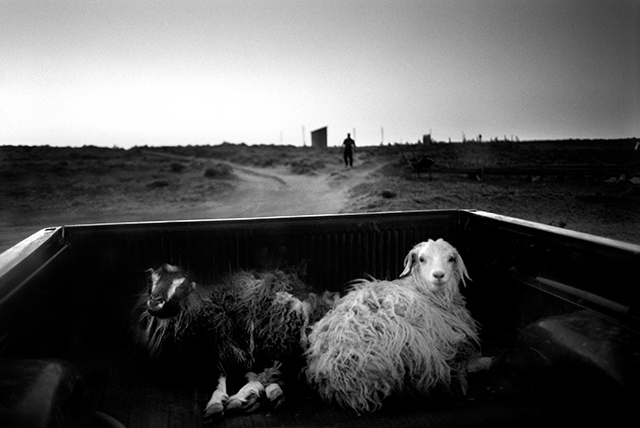
Dusk, Jeddito. © Stacia Spragg-Braude
SEE: Stacia, your ties with the Begay family have given you a unique perspective. You became part of their family and the Navajo culture. How did that close relationship come about? Do you see connections between the urban, non-native world and the native world?
SSB: I think part of the answer is I just came with an open heart and said, ‘I’m interested in your story. I believe in this.’ But the majority of all this came from the acceptance of the family. They just took me in and trusted me. The trust built over the years.
SEE: Why do you think they trusted you at first? Just because of your openness?
SSB: I don’t know! I guess it speaks to them to give me the benefit of the doubt because they had no reason to. They didn’t know me and I was working for a newspaper. Why would they do that? I credit them. The family strikes me as folks who are very much in tune with their gut feeling. I came with the best of intentions and I think they sensed that. Part of it too was their mission to try and restore this type of sheep and spread the word. And, they could tell that I share a belief in that mission too.
SEE: You make a point that the re-introduction of the Churro sheep brought the Begay family back together. It brought Mary and Goldtooth (the mother and father) out of alcoholism. I’d like to hear about some experiences you’ve had with them and how you might put into words how important these sheep are to them.
SSB: I wish I would have had met them before they got the Churro because it’s based on what Goldtooth and Mary’s children have told me. There was a lot of despondence and a lot of disunity. The family wasn’t spending as much time together. The girls, Sharon and Alta, went away to graduate school in Minnesota, halfway across the country! So that furthered the sense of isolation for their parents. It wasn’t until they met Lyle—and their parents came up to visit them and met him, too—that they had this mission. This was back in the 70s and I didn’t know them then. But when I met them in the mid 90s, what I saw every weekend, was that the family members would come out to Jeddito and spend time, make dinners, and attend ceremonies, and Mary was weaving again—before she wasn’t doing much of that. Goldtooth was pretty old by that point but he would still wander outside and help with the shearing. Sharon would tell me that hearing the sound of the sheep bells in the morning brought her parents such joy. They noticed a difference in their parents’ happiness and well being, just hearing that reassuring sound! It gave them a sense of purpose. They had to go out there to take care of the sheep.
SEE: Was it particularly the Churro sheep that made them happy? What if it had been some other breed?
SSB: Well, Sharon told me, that when Goldtooth, her father, first saw them he said, “Those are the old-time sheep!”
It was like getting back to the real thing as opposed to sheep that Americans brought in, during the early 20th century. His association was with this particular breed of sheep that was from their Holy People. The medicine men revered them and the elders would see the markings on their heads as being touched by God. It was the real deal for them. That was always the impression I had—this sense of happiness and peace with having this particular sheep back. It just felt like home to them.
That’s what drew me, as a journalist and an artist, to how this particular sheep, the history of it, really mirrored that of the Navajo people. During the Long Walk these sheep were the first targeted and chased down into Canyon de Chelly. Then during the Dust Bowl era, when the flocks were thinned out, they were the first ones targeted because they looked weaker, even though they were well adapted to the dry, harsh climate. They looked scraggly. They had the long, messy wool. Their history really parallels that of the Navajo people. Their resurgence…the family felt that it symbolized the heart of their identity as Navajo.
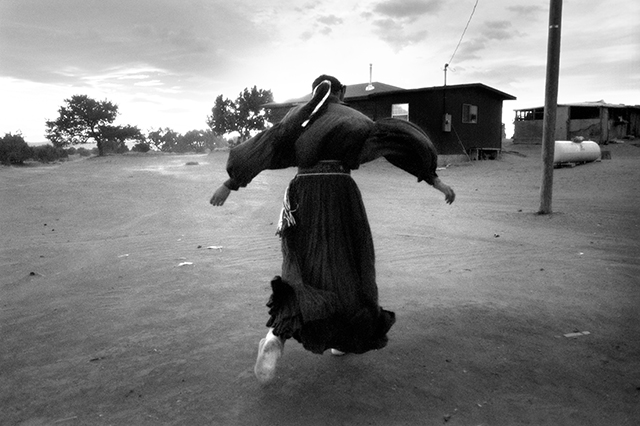
Running west to meet the Holy People. © Stacia Spragg-Braude
SEE: It appears that as an artist and photographer, you were drawn to their sacred connection to the sheep. Can you expound on that?
SSB: It was! To me it was that strong of a metaphor. I really didn’t have any experience with sheep before this, but they so identified with them. The sheep embody who the Navajo are and their resiliency. The Churro sheep was almost endangered by the 1970s.
I don’t have the exact figures but there were very few left by the time Lyle McNeal sort of stumbled in and resurrected them by bringing them back. It was bringing back who they [the Navajo] were before all this stuff ever happened—their strength and their beauty.
I was really going in different directions because, as a photojournalist, I would have been covering everything about them. And with this story, I was just interested in how, by saving the sheep, the sheep are saving the family. If you look through my work, you see that I don’t have many pictures of sheep. It’s not literal…more symbolic. The story was meant to address the question ‘what have the sheep brought back to this family?’
SEE: It seems like part of it was giving them back a sense of purpose and a shape to their lives.
SSB: Definitely! The Navajo elders would say the Holy People brought them. The Western understanding is that the Spanish brought them from the Iberian Peninsula. When the Navajo started raising the sheep, they were nomadic. They based their lives around them and their sustenance off of them. And then that is slowly stripped away in the 19th and 20th centuries. By bringing these sheep back it’s like ‘oh yeah, this is who we were.’ The members of the family would say ‘Even if we just had one or two sheep for the next generation they’ll still embody what it means to be Navajo for the younger generation.’ You don’t have to raise huge flocks in order to benefit from it. By having one or two you’re going to remember who you are. That really inspired me as a photographer. And the shooting was very intuitive. It wasn’t until my son was born that I realized things had come full circle, because one of the girls who’s coming of age ceremony I’d photographed had her baby around the same time. It was really full circle.
SEE: Sounds like there are a lot of circles in this story.
SSB: There were! And still are.
SEE: It comes through in your book that you were going in, as you said, with an open heart. Just trying to understand. When I’m looking at this book of yours, and I allow myself to sit with it, to feel it, I get a sense of peace and serenity from it. And I’m wondering if that’s something you felt while making pictures.
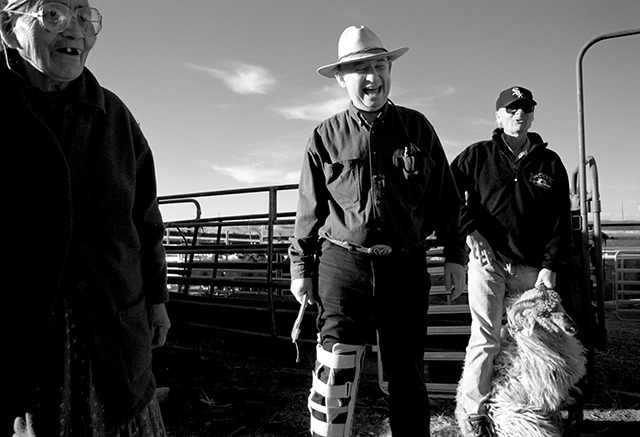
Lyle McNeal, the sheep man - haastin dibé - bringing the Churro back to the Navajo Nation. © Stacia Spragg-Braude
SSB: Absolutely. What motivated me all along was the sense that any culture, any family, could identify with the Navajo in terms of trying to figure out who they were as a people, connect to their ancestry and figuring out what they’re going to save for their kids. So me being an outsider and not having any kind of background in Native American Studies I can come in and say ‘here’s my filter,’ it can pass through me. I don’t have that kind of connection with my ancestry past my grandparents. And here you guys do! What a beautiful thing that you can inspire others to contemplate what ‘cultural identity’ means. So I was going for the bigger picture. Anyone could identify with their story. It would be so different to do this story today. Fortunately now a lot of younger Navajos have cell phones and cameras and the ability to edit multi-media stuff. They can get their own interpretation out. But this is my version of their story. If they were to edit it, it would look very different. Lyle McNeal would edit it very differently. When I did the edit for the book, I knew that this wouldn’t be a family photo album. This is my take of our journey together. For better or worse, I don’t know!
SEE: No, it works beautifully. You tapped into and looked at what was universal about being a family and being a part of a specific culture.
SSB: Right! And maybe that’s the benefit of being an outsider. We often think we’re limited because we don’t have the perspective of an insider or the access. But maybe what an outsider can bring is a sense of the universal, that we’re not so disconnected that we can’t see underlying themes and patterns and be able to relate to other people who aren’t of the same group.
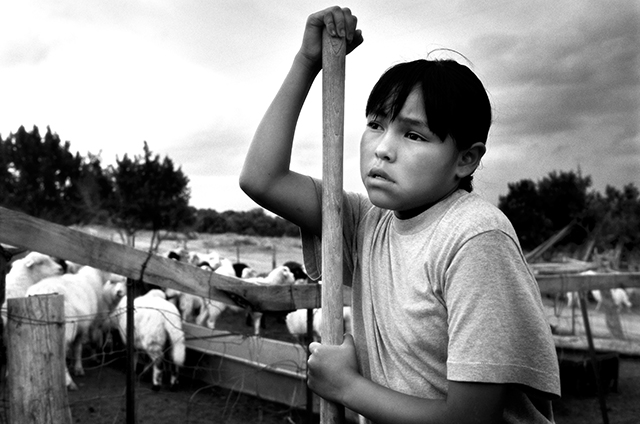
Heather, herding her family's sheep. © Stacia Spragg-Braude
SEE: Right, exactly. It’s a human thing! It comes down to just being human and a family. I get that by looking at the book. The elders telling their kids, ‘You have to get up in the morning, there are things to be done!’ I love that quote by Mary, telling them when they were home on the weekends, ‘Five o ‘clock in the morning you’ve gotta get up!’ I think a lot of us are interested in our ancestors.
SSB: When I saw this family really connecting to place, it ultimately made me question my own connection to place. I moved around a lot and I don’t feel particularly connected to where I grew up. I’m not living there. That just segued into the next work after the Navajo project that I did recently about a farmer. I explored that theme even more, about settling in a place and knowing the land, building community. So this work informed the next.
SEE: Yes. Can you give me some examples of how the idea of land informs the work with the Navajo?
SSB: What impressed me most—when we’d be driving out around the reservation, Sharon, especially because she’s the storyteller in the family, but other members too—is the stories they would tell of their mythology and their history. Sometimes we’d see landforms and they’d tell of something that happened there. And part of it was wondering, did it really happen? You start getting into that whole Joseph Campbell idea that there could be these layers of understanding of a place. It wasn’t just the geological understanding of the land or the history of who lived there when, or what building was there when. It was a combination of myth and spirituality, spiritual stories and family stories all thrown together.
It came from an understanding that the land took on a life of its own. And when I met the Begays, it showed in how they interacted with the land. It wasn’t just a linear progression of time. The past was so much alive today. We tend to let go of that--that this is the past and we’re supposed to focus on the present moment. But yet it’s intertwined with what has happened before as well as with the dreams and plans we have for the next generations.
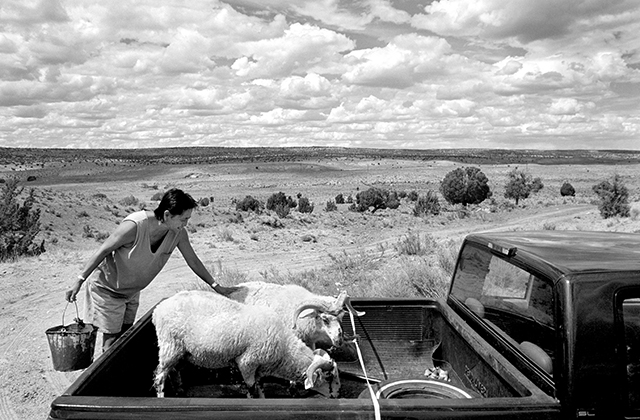
Lena, cooling off Churro rams at the springs. © Stacia Spragg-Braude
SEE: That brings me around again to this idea of connections—connections between all different kinds of people and different generations as well. I think we share these things, though maybe we aren’t aware of them until we start to talk about them. And when we start seeing these connections we come together more as human beings.
SSB: Absolutely. I don’t think we have the time to do that. We get so caught up with technology that there’s no downtime when you would actually process that and let all those things collide. We don’t have that kind of processing time anymore. Everything is really in the moment with today’s Tweet and today’s cause. I think activists can get so caught up in a particular cause that maybe the bigger picture might be lost because they’re so tightly focused. I think this is where artists can come in. Artists are on a permanent ‘smoke break!’
You know what I mean? Step back and allow that non-linear time to happen—for all this stuff to collide.
I think that’s why I like people who raise animals or live on a farm because there is that time. When you’re working with animals you’re on a different time. You’re not on human time. You’re not on computer time. You’re in the bigger picture and you can slow down and allow those connections to happen. So that then you’re able to look at this and say, ‘wow, look at what these sheep have done for this family and for identity. Why is that appealing to so many people? Well, because we all crave some connection or conduit, some kind of continuity. We live in an era where things disappear in a few years and they change. Restaurants, neighborhoods, fields, whatever. We crave things that will last from generation to generation, be it a farm, a piece of land, an animal, an art like weaving, something that connects us to people who have come before and will outlast us. This is what attracts me to the artist part of it.
Al and Sharon, prayer, Mount Taylor. © Stacia Spragg-Braude